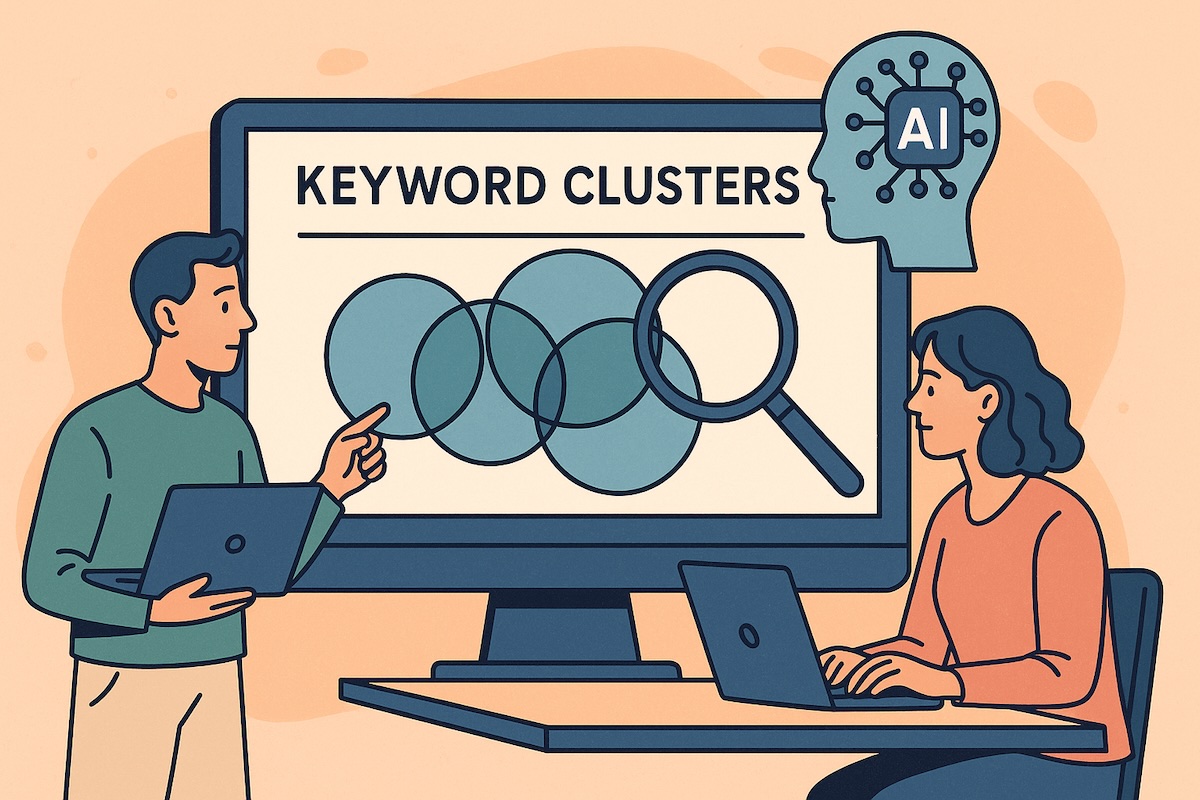Why AI Keyword Clustering is Transforming WordPress SEO
AI is shaking up the way we think about SEO. If you run a WordPress site, you’ve probably noticed that ranking for just one keyword isn’t enough anymore. Search engines have gotten smarter, and so have the strategies that actually work. AI keyword clustering is at the heart of this shift. It’s not just a buzzword. It’s a practical, data-driven way to organize your content and boost your rankings.
So, what is AI keyword clustering? In plain English, it’s the process of using artificial intelligence to group together keywords that are closely related in meaning or intent. Think of it as semantic keyword grouping on autopilot. Instead of guessing which keywords belong together, AI analyzes massive amounts of data to spot patterns and connections you’d probably miss. The result? You get clusters of keywords that help you build a stronger, more focused SEO content strategy.
Why does this matter for WordPress site owners? For starters, WordPress powers over 40% of all websites, so competition is fierce. AI keyword clustering helps you organize your content in a way that search engines love. You’ll avoid keyword cannibalization (where your own pages compete against each other), build topical authority, and make your site easier to navigate. That means better rankings, more traffic, and a smoother experience for your readers.
Traditional keyword research is all about finding that one perfect keyword for each page. But Google’s algorithms have moved on. Now, they look for content that covers a topic in depth, not just a single phrase. Modern SEO is holistic. Clustering lets you target whole groups of related keywords, so you can rank for dozens of terms with one well-structured post or page. According to industry studies, sites that use keyword clustering can see up to a 40% increase in organic traffic compared to those that stick with single-keyword targeting. (Of course, results vary, but the trend is clear.)
Here’s what you’ll get from this guide:
- Clear definitions of AI keyword clustering and why it matters for WordPress
- A breakdown of how clustering beats old-school keyword research
- Real benefits for WordPress users, from better rankings to smarter site structure
- A look at the tech behind clustering (without the jargon overload)
- Step-by-step advice for putting clusters to work on your own site
- Tips for using clusters to spot content gaps and build authority
AI isn’t just a fancy add-on anymore. It’s changing the rules of SEO, especially for WordPress. If you want to stay ahead, understanding AI keyword clustering is a must. Ready to see how it all fits together? Let’s get into the details.
AI keyword clustering is changing how people approach SEO, especially for WordPress sites. Instead of treating keywords as isolated targets, this method uses artificial intelligence to group related search terms together. The result? Smarter content strategies, fewer missed opportunities, and a real shot at building topical authority. But how does it actually work, and why does it matter so much for WordPress users? Let’s break it down.

What is AI Keyword Clustering?
At its core, AI keyword clustering is about using machine learning to find patterns in huge lists of keywords. Instead of manually sorting through hundreds (or thousands) of terms, AI algorithms analyze how keywords relate to each other. They look for semantic similarities (words that mean similar things) and search intent (what users are actually looking for). The AI can spot connections that most people would miss, grouping keywords into clusters that make sense for both search engines and real readers.
Here’s the technical bit, but I’ll keep it simple: AI models process keyword data using natural language processing (NLP). They measure how closely related different terms are, often by looking at how they appear together on web pages or in search results. Some tools even analyze which URLs rank for multiple keywords, revealing hidden relationships. The end goal? To create clusters of keywords that can be targeted together in a single piece of content or across a tightly linked group of posts.
This approach is a big leap from the old days of picking one keyword per page. With AI, you’re not just guessing which terms belong together. You’re letting data and algorithms do the heavy lifting, which usually means better results and less wasted effort.
SERP-Based vs. Semantic Clustering
There are two main ways AI groups keywords: semantic clustering and SERP-based clustering. Both have their place, but they work differently.
Semantic clustering focuses on meaning. It uses NLP to group keywords that are similar in definition or context. For example, "best running shoes" and "top sneakers for runners" would end up in the same cluster because they mean almost the same thing. This method is great for understanding language, but it sometimes misses how Google actually treats those keywords in the real world.
That’s where SERP-based clustering comes in. This approach looks at the search engine results pages (SERPs) for each keyword. If two keywords bring up a lot of the same URLs in the top results, they’re probably targeting the same intent. So, they get grouped together. This method is more practical for SEO because it reflects how Google sees the relationship between keywords, not just how they’re defined in a dictionary.
Most SEOs (myself included) find that SERP-based clustering usually delivers better results. It helps you avoid creating separate pages for keywords that Google already sees as the same topic. That means less keyword cannibalization and a stronger shot at ranking higher for multiple terms with a single, well-optimized post.
Key Benefits for WordPress Sites
So, why should WordPress site owners care about AI keyword clustering? The benefits go way beyond just saving time. Here’s what you actually get:
- Keyword cannibalization prevention: By grouping related terms, you avoid creating multiple posts that compete for the same search intent. This keeps your content focused and your rankings stronger.
- Topical authority building: Covering all the angles of a topic in a structured way signals to Google that your site is an authority. Clusters help you plan content that covers every subtopic, not just the obvious ones.
- More efficient content planning: Instead of guessing what to write next, clusters show you the gaps and opportunities. You can build out a content calendar that actually makes sense.
- Better internal linking opportunities: Clusters naturally lend themselves to smart internal links. You can connect related posts, which helps both users and search engines navigate your site.
- Improved user experience through comprehensive content: When you cover a topic from every angle, visitors stick around longer. They find what they need without bouncing back to Google.
- Higher rankings for multiple related terms: Targeting clusters means you’re not just aiming for one keyword per page. You can rank for dozens of related terms with a single, well-structured post.
- More strategic use of WordPress categories and tags: Clusters make it easier to organize your site. You can assign posts to the right categories and tags, making your site structure cleaner and more logical.
Here’s a real-world example. A WordPress blog in the fitness niche used AI keyword clustering to overhaul its content strategy. Instead of writing separate posts for "HIIT workouts for beginners," "beginner HIIT routines," and "easy HIIT exercises," they combined these into a single, comprehensive guide. They used SERP-based clustering to confirm that Google treated these terms as the same intent. After updating their content, they saw improved rankings for all three terms (and a bunch of long-tail variations), plus a noticeable bump in organic traffic. That’s the power of clustering in action.
The bottom line? AI keyword clustering isn’t just a technical trick. It’s a smarter way to plan, organize, and grow your WordPress site. Whether you’re trying to prevent keyword cannibalization, build topical authority, or just make your content strategy less of a headache, clustering gives you a real edge.
How AI Clustering Algorithms Work
Common AI Clustering Algorithms Explained
AI keyword clustering relies on a few core clustering algorithms that group keywords based on their similarities. The most common ones you'll see in SEO tools are Centroid Clustering, Agglomerative Clustering, and K-means Clustering. Each has its own strengths, quirks, and ideal use cases. If you're serious about keyword clustering algorithms, it's worth knowing how these work under the hood.
Centroid Clustering works by picking a central keyword (the centroid) for each group. Every other keyword gets assigned to the group whose centroid it's most similar to. This method is fast and works well when you want clear, distinct clusters. It's great for large keyword lists where you need to quickly spot the main topics. But it can sometimes miss subtle relationships between keywords that don't fit neatly into one group.
Agglomerative Clustering is a type of hierarchical clustering. It starts by treating every keyword as its own cluster, then gradually merges the closest pairs until only a few big clusters remain. This approach is more flexible and can reveal hidden connections between keywords. It's especially useful when you're dealing with a niche topic or want to see how subtopics relate. The downside? It can be slower on massive lists, and sometimes the clusters get a bit too broad.
K-means Clustering is probably the most famous. You tell the algorithm how many clusters you want (the "K"), and it sorts your keywords into those groups based on similarity. It's fast and works well for balanced datasets. But if you pick the wrong number of clusters, you might end up with awkward groupings. K-means is a solid choice when you have a rough idea of your site's main topics and want to organize keywords around them.
Most modern AI keyword clustering tools let you pick between these algorithms or even combine them. The best choice depends on your goals, the size of your keyword list, and how much nuance you want in your clusters. If you're curious about how these algorithms fit into a real SEO workflow, check out the Republish AI's WordPress AI Playbook for practical tips.
NLP and Machine Learning in Keyword Analysis
Clustering algorithms are just the start. The real magic happens when you add Natural Language Processing (NLP) and machine learning to the mix. NLP keyword clustering lets AI understand the actual meaning behind keywords, not just the words themselves. It can spot synonyms, related phrases, and even subtle differences in search intent. Machine learning takes it further by learning from huge datasets and improving its accuracy over time. The more data it sees, the better it gets at grouping keywords in ways that make sense for real users.
There are a few main NLP approaches used in keyword clustering. Some focus on the literal words (like bag-of-words models), while others use advanced techniques like word embeddings or transformer models. Each has its own strengths, and the best tools often combine several methods for the most accurate results.
Approach | How It Works | Best For |
|---|---|---|
Bag-of-Words | Counts how often each word appears in a keyword or phrase. Ignores word order and context. | Simple keyword lists, basic topic grouping |
TF-IDF (Term Frequency-Inverse Document Frequency) | Measures how important a word is in a set of keywords compared to all keywords. Highlights unique terms. | Finding unique topics, filtering out common words |
Word Embeddings (e.g., Word2Vec, GloVe) | Turns words into vectors based on their context in large datasets. Captures meaning and relationships. | Semantic keyword grouping, finding related phrases |
Transformer Models (e.g., BERT) | Uses deep learning to understand context, word order, and subtle meaning. Can handle complex queries. | Advanced search intent analysis, nuanced clustering |
If you're wondering why some tools seem to "get" your keywords better than others, it's probably because they're using more advanced NLP and machine learning under the hood. The difference is huge, especially for long-tail keywords or topics with lots of overlap.
Search Intent Recognition in Clustering
Grouping keywords by topic is powerful, but the real SEO wins come when you factor in search intent analysis. Modern AI clustering tools can spot not just what a keyword is about, but what the searcher actually wants. That means you can cluster keywords by intent: informational (looking for answers), navigational (trying to find a specific site), commercial (researching products), or transactional (ready to buy).
Why does this matter? Because two keywords might look similar but belong in totally different clusters if the intent is different. For example, "best running shoes" (commercial) and "how to clean running shoes" (informational) shouldn't be grouped together, even though they share a topic. Smart clustering keeps your content focused and helps you avoid keyword cannibalization.
- "WordPress SEO tips" (Informational): Users want advice or guides.
- "WordPress SEO plugin" (Navigational): They're looking for a specific tool.
- "Best WordPress SEO tools" (Commercial): They're comparing products.
- "Buy WordPress SEO service" (Transactional): They're ready to make a purchase.
Each of these keywords could fall under the broad topic of WordPress SEO, but a smart AI will cluster them separately based on what the user is actually after. This is where search intent analysis really shines. If you want to see how intent-based clustering can transform your content strategy, the AI WordPress SEO breaks down real-world examples and practical steps.
Bottom line: AI keyword clustering isn't just about grouping similar words. It's about understanding meaning, context, and intent. The best tools use a mix of NLP keyword clustering, machine learning, and intent recognition to help you build smarter, more effective SEO strategies. And if you're using WordPress, these insights can make a real difference in how you organize your site and plan your content.
Implementing AI Keyword Clustering for WordPress
Step-by-Step Implementation Guide
Getting AI keyword clustering working for your WordPress site isn't rocket science, but it does take a bit of planning. Here’s a practical, WordPress-focused approach that’ll actually move the needle for your SEO content strategy.
- Gather initial keyword data: Start by pulling a big list of keywords relevant to your niche. Use tools like Google Search Console, Ahrefs, or SEMrush to export keywords you already rank for, plus those your competitors target. If you’re just starting out, Google’s Keyword Planner or even AnswerThePublic can help you brainstorm. For WordPress users, plugins like Rank Math or Yoast SEO can surface some of this data right in your dashboard.
- Choose the right clustering tool: Not all AI keyword clustering tools are created equal. Some, like Keyword Insights and SEO.ai, focus on SERP-based clustering, which tends to work better for real-world rankings. Others lean on semantic grouping. If you want something that integrates with WordPress, keep an eye out for tools that offer CSV exports or direct plugin support. Republish AI is building out solutions tailored for WordPress users.
- Set clustering parameters: Most tools let you tweak how strict the clusters are. For example, you might set a minimum URL overlap for SERP-based clustering, or adjust semantic similarity thresholds. If you’re not sure, start with the default settings. You can always refine later. The goal is to group keywords that could realistically be targeted by a single page or post.
- Analyze cluster results: Once your tool spits out clusters, look for patterns. Are there clusters that match your existing site structure? Any surprises? Pay attention to clusters with lots of high-volume keywords—these are usually good candidates for pillar content. If you see clusters that overlap with your current posts, you might have a keyword cannibalization problem.
- Organize clusters in a usable format: Export your clusters to a spreadsheet or use a project management tool like Trello or Notion. For WordPress, it helps to map clusters to your categories, tags, or even custom taxonomies. This makes it way easier to plan content and keep your site organized as you grow.
- Implement findings in WordPress: Now the fun part. Use your clusters to guide new content creation, update old posts, and build internal links. For each cluster, create a pillar page (or update an existing one) that targets the main keyword, then link out to supporting articles for the subtopics. Use WordPress features like categories, tags, and menus to reflect your new topic cluster model. If you’re using a plugin like Republish AI, you can automate some of this process and keep your clusters up to date.
You don’t have to do all this in one sitting. Even just mapping your top clusters to your main categories can make a huge difference in how Google (and your readers) see your site.
Integrating Clusters into WordPress Content Strategy
Once you’ve got your keyword clusters, it’s time to put them to work. This is where a lot of sites drop the ball—they do the research, but never actually change how they plan or organize content. Here’s how to make those clusters the backbone of your SEO content strategy.
- Plan your content calendar around clusters: Instead of brainstorming random blog topics, use your clusters to schedule posts. Each cluster becomes a mini content series. For example, if you have a cluster around "WordPress SEO plugins," plan a pillar post plus supporting articles on setup, comparisons, and troubleshooting.
- Structure your site architecture: Map major clusters to your main categories or even custom taxonomies. In WordPress, you can create custom taxonomies using plugins like Custom Post Type UI. This helps both users and search engines understand your site’s topical structure.
- Organize categories and tags: Assign each post to the most relevant cluster-based category. Use tags for subtopics within clusters. This keeps your site tidy and makes internal linking a breeze.
- Create pillar pages and topic clusters: For each big cluster, build a comprehensive pillar page that covers the main topic. Link out to supporting posts that dive into subtopics. This is the classic topic cluster model—and it works. WordPress makes this easy with its built-in page and post hierarchy.
- Leverage internal linking: Use your clusters as a roadmap for internal links. Every supporting post should link back to its pillar page, and related posts within a cluster should link to each other. This boosts topical authority and helps prevent keyword cannibalization.
- Use menus and navigation wisely: Reflect your clusters in your site’s navigation. For example, add dropdowns for each major topic, or feature pillar pages in your main menu. This isn’t just good for SEO—it makes your site way easier to browse.
Using Clusters for Content Gap Analysis
Here’s where AI keyword clustering really pays off. Content gap analysis is about finding the topics your competitors rank for—but you don’t. With clusters, you can spot entire areas where your site is missing out.
- Export competitor clusters: Use your clustering tool to analyze a competitor’s keyword rankings. Many tools let you input a competitor’s domain and pull their top clusters.
- Compare with your own clusters: Lay your clusters side by side with your competitor’s. Look for clusters where they have content and you don’t. These are your biggest opportunities.
- Identify high-value gaps: Not every gap is worth filling. Focus on clusters with high search volume or strong commercial intent. If a competitor has a whole cluster on "WordPress speed optimization" and you don’t, that’s a clear target.
- Create or update content: For each gap, plan a new pillar page and supporting articles. Or, if you already have some content, update it to better match the cluster’s search intent. Use your keyword data to guide titles, headings, and internal links.
- Track progress in WordPress: Use your dashboard to keep tabs on new posts and updates. Many SEOs use a spreadsheet or project management tool to track which clusters have been covered. In WordPress, you can filter posts by category or tag to see your coverage at a glance.
Picture this: You’re in your WordPress dashboard, filtering posts by the "SEO content strategy" category. You notice you’ve got plenty of posts on on-page SEO, but nothing on technical audits. That’s a content gap. By mapping clusters to categories, you can spot these holes fast—no fancy software required.
Here’s what a basic content gap analysis might look like in a spreadsheet (or even a WordPress dashboard with the right filters):
Cluster Topic | Competitor Has Content? | You Have Content? | Action Needed |
|---|---|---|---|
WordPress SEO plugins | Yes | Yes | Update pillar page |
Technical SEO audits | Yes | No | Create new cluster content |
Content gap analysis | Yes | No | Research and publish |
Topic cluster model | Yes | Yes | Add more supporting posts |
You don’t need a fancy plugin to get started, but if you’re serious about scaling, tools that integrate with WordPress (like Republish AI) can save you hours. They’ll help you keep your clusters, categories, and content all in sync—so you’re not missing out on easy wins.
Bottom line: AI keyword clustering isn’t just a research trick. It’s a practical way to organize your WordPress site, plan smarter content, and spot the gaps that’ll actually move your rankings. The more you bake clusters into your workflow, the more you’ll see your site’s authority and traffic grow.
Maximizing Your WordPress SEO with AI Keyword Clustering
AI keyword clustering has changed the way we think about SEO content strategy for WordPress. Instead of chasing single keywords, you can now group related terms, build out entire topic clusters, and organize your site in a way that search engines (and real people) actually understand. That shift is huge. It means you’re not just optimizing for one search, but for dozens—sometimes hundreds—of related queries at once.
The real magic? Improved rankings and better content organization. When you use AI to cluster keywords, you’re not just guessing what Google wants. You’re using data to prevent keyword cannibalization, spot content gaps, and make sure every post has a clear purpose. That’s how you start topical authority building—and that’s what Google rewards.
It’s not just about today’s algorithms, either. Search is always changing. AI keyword clustering seems likely to get even smarter as natural language processing and machine learning keep evolving. The tools will probably get better at understanding intent, context, and even the subtle ways people phrase their questions. If you’re already using clusters, you’re ahead of the curve. If not, now’s the time to start.
- Group your keywords by topic, not just by volume.
- Map out your content so every post supports a bigger theme.
- Use clusters to guide your internal linking and site structure.
- Watch for cannibalization and fill content gaps as you find them.
You don’t have to overhaul your whole site overnight. Even small steps—like clustering your next batch of keywords or updating a few posts to fit a topic model—can make a real difference. The key is to start. And if you want to make things easier, there are tools built for this exact job.



